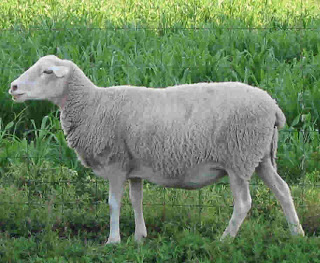
Necks are pretty important, and just the thought of a “broken neck” evokes a visceral cringe in most of us. In dogs, there can be necks that, while not broken, don’t function at an optimum level, and the “ewe neck” is such a neck. As the picture suggests, the term is taken from sheep.
On the face of it, a neck is a neck is a neck, right? One need only look at the Norwegian Lundehund’s neck functions to know this isn’t true. Neck carriage can be breed specific and is closely associated with a breed’s original function. The Curly Coated Retriever standard, for example, calls for a strong and slightly arched neck of medium length, free from throatiness and flowing freely into moderately laid-back shoulders. Consider what this breed does “for a living:” She needs to be able to see the terrain, and a neck of moderate length certainly helps with this. Throatiness (an excess of loose skin under her throat) would impede both her progress and her safety when retrieving a bird from brush, while that slightly arched neck provides her with more muscle power and support when she picks a bird up with her mouth, particularly if it’s a heavy bird.
A Chihuahua doesn’t need a strong, medium-lengthed neck free of throatiness, and its standard doesn’t call for it. What it does call for is a slightly arched neck that gracefully slopes into lean shoulders. Sharp eyes may have noticed that both the Curly Coat and Chihuahua standards call for a slightly arched neck. While it might be incorrect to say that the opposite of a slightly arched neck is a ewe neck, it’s not too far off. An arched neck is thicker at the base than where the head and the windpipe meet, thus it has a stronger neck ligament which offers more power for the dog’s shoulder blades and front leg muscles.
In their book, K-9 Structure and Terminology, Edward M. Gilbert Jr., and Thelma R. Brown liken the structure to a doorway. An arched doorway is structurally stronger than other forms. Because a dog’s shoulder blade muscles are attached to her neck, an arched neck is superior, structurally speaking, at withstanding the “pull” from those shoulder blades.
Conversely, a ewe neck has weaker neck ligaments, and because of that weakness, there is less support for the shoulder blades and front leg muscles. Straight shoulders with less muscle stress the dog’s back, and that can result in a dip in the topline. Visually, a ewe neck is concave on the neckline and lacks any indication of an arch. This kind of neck abruptly joins the shoulders and back, almost as if the neck was a Mr. Potato piece that was simply stuck into a potato – no flow, no gentle arch. Often, the girth of a ewe neck is also the same at the top as it is at the bottom. Besides being unpleasing to look it, this neck lacks muscle and support.
We don’t have permission to reprint a good illustration of the same neck in a dog, but you can see one here: The same article from Canine Chronicle provides an in-depth explanation of the neck in terms of the cervical vertebrae – and, by the way, did you know that dogs have the same number of vertebrae as a Giraffe?

Excellent explanation!
Much appreciated, Barbara, thanks for leaving the positive comment!